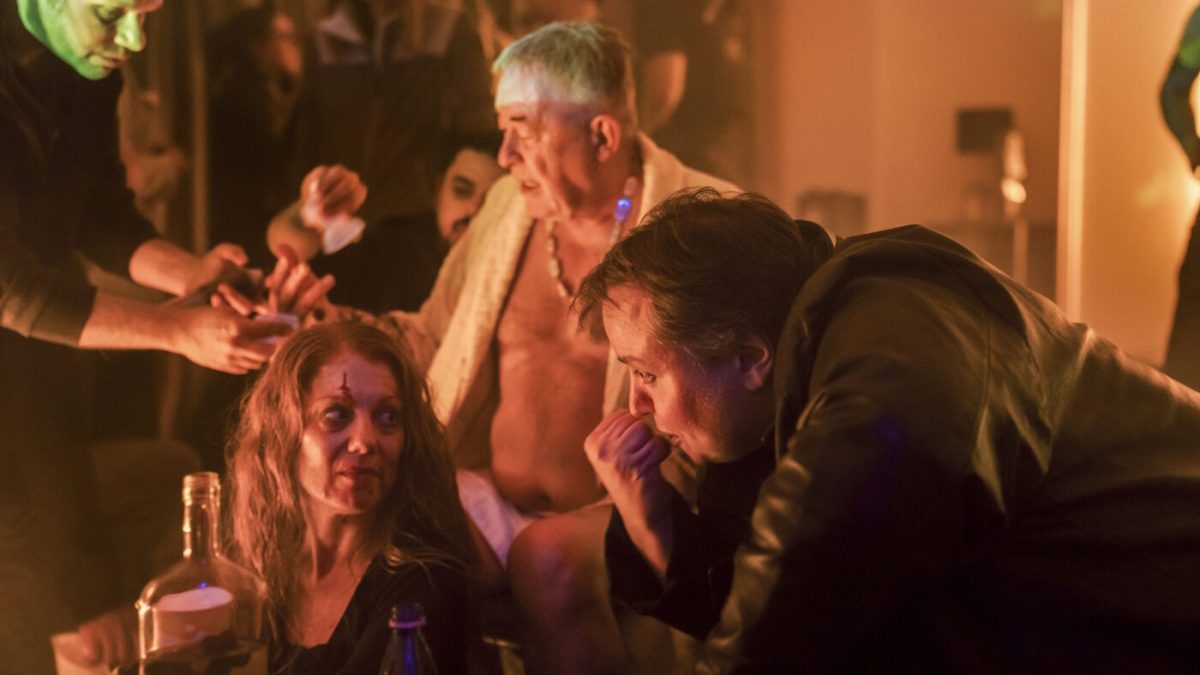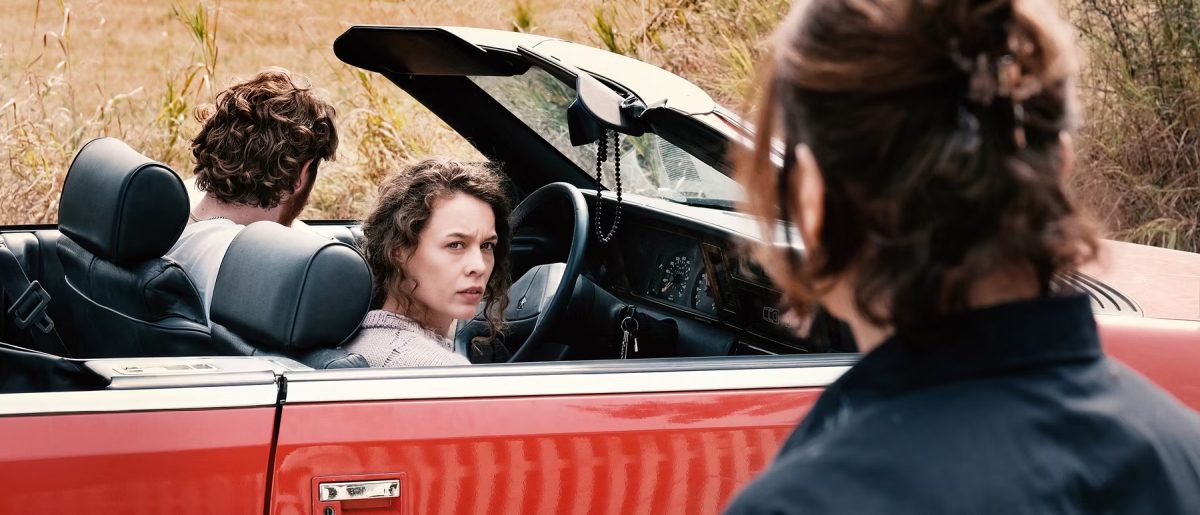The last time Aleksandar Radivojevic put pen to paper for the silver screens, the end result caused a tectonic shock unprecedented in recent memory. Since the premiere of Srdan Spasojevic’s Serbian Film – a nightmare about a retired porn star who is lured into a final job that descends into necrophilia and incest (let’s leave it at that) – the film has been the subject of much notoriety internationally, and perhaps even more so, domestically, for the mere thought of the events depicted in the film, regardless of its visual depiction. Which was not lacking either. Now, 15 years later, Radivojevic returns with his directorial debut who may not be squeamish about taboos, but make no mistake, “Karmadonna” is a shock to a system that takes no prisoners.
“Karmadonna,” Aleksandar Radivojevic’s directorial debut, recently premiered at TIFF’s Midnight Madness program. The film begins with a long shot of two children fighting over a smartphone showing an unskippable anti-smoking ad. All around them, all kinds of events are unfolding under sunny skies. All the fuss doesn’t seem to bother Jelena (Jelena Dokic) – a beautiful woman well beyond her youth and middle age – fascinated by her miraculous and completely unexpected pregnancy; Apparently it is achieved through in vitro fertilization. Everything changes once she receives a call from an unknown god, the self-proclaimed “Content Creator” (Sergei Trifonovich).
The voice accurately predicts the horrors that are about to unfold near Jelena, a testament to its power before the final gambit. He wants her to “kill some people.” At first, she is hesitant, but when she realizes that the voice is not an illusionist, but rather God himself, who has actual powers to harm her unborn child, she gives in. Jelena becomes a woman on a mission to punish the “untouchables” – even for God’s sake.
From the long opening shots, to the large zooms and constantly moving camera, to the static and choreographed shots, it has been a long time – if ever – since we have seen a Serbian film with such visceral kinetic energy. “Karmadonna” is an assault on the senses, with Aleksandar Jaconić’s camera acting as a relentless instrument, its constant movement and shifting angles underscoring every tonal and emotional shift – desires, doubts and anxieties that could come straight from a De Palma film.


More horror movies: 10 great foreign horror movies you can watch now
One scene in particular is an almost direct homage to the “twisted nerve sequence” from Kill Bill (2004), itself a partly De Palma-esque homage. In a way, “Karmadonna” is an update of “Kill Bill.” While Tarantino’s two-part, cross-genre epic is a revenge tale about a mother seeking to punish those who killed her husband and unborn daughter (or so the Bride thought at the beginning of the first film), Jelena, by contrast, is not driven by revenge. Led by God Himself over the phone, Imtiaz Jelena is driven by her desire to cleanse the evils around her in hopes of bringing her child to a better world. Although it follows a similar chain-of-drive murder structure, unlike “Kill Bill” — an action coat rack of many genres — “Karmadonna” is a grinding horror film, playing like a comedy for a good portion of its running time.
One description that will be thrown around is that the film is like “The Omen” (1976) with “John Wick,” and although there is some truth to that, the film plays like a joke on these settings, rather than playing it straight. The names Sam Raimi and perhaps De Palma come to mind when describing the film’s dark humor, but the comparison doesn’t do the grotesque humor justice. Raimi’s influence extends aesthetically as well, as many of the tracking shots glide just above the ground, approaching their subjects like an invisible force – the type of shot most associated with Raimi’s early work.
In the film Antichrist (2009) by director Lars von Trier, nature is declared to be the Church of Satan. Although Radivojevic’s view of the world appears similar, it is in many ways more skewed. For the world to be Satan’s church, it must be a creature that celebrates life and certain values, even if they are evil values. The world of Carmadonna has no morals.
It’s a combination of an Old Testament God, with heavy Buddhist influences, but after passing through the Radivojevic filter, this Creator of all life is not a moral God. This God does not advocate self-control and control over all impulses and impulses, as in Christianity or Buddhism, but on the contrary. In the movie, all life is made of boredom. Life is a celebration of impulsiveness, and all known religious morals are merely man-made control mechanisms.
God, or the Bhagavad Gita (hence the “karma” in the film’s title), is not interested in openly punishing evildoers, but rather those who violate this principle. At some point, Jelena confronts the voice: Why target a Nebo-born influencer and best-selling self-help book author with a history of abuse (played by Petar Strogar), when there are countless criminals out there causing more harm who should be at the top of the list? God answers that such thinking is trite, and that the worst offenders are actually people like the influencer in question.


Must check: Top 10 horror movies to watch on Halloween
To many of the film’s critics, this seemed like a superficial attack on influencer culture, but what they seem to miss is that many of these “Not So Bad” characters are not only malicious, but also offer a veneer of morality by purging themselves of hedonistic vices. In a way, these people act as managers of the libidinal economy, presenting themselves as virtuous for having quit smoking, while leading the public into a deeper moral decadence, where urges and vices are micromanaged, yet new forms of quietly decadent enjoyment are allowed. This is most evident in the film’s subplot of a reality show that helps people quit using drugs, while facilitating other types of sodomy behind closed doors. When comparing this feeling to the themes of the two films Radivojevic had previously written, the overarching theme becomes clear.
In Tears for Sale (2009), we encounter women who make their living through performative grief, that is, by crying at funerals for money. Later, in “A Serbian Film” (2010), the main protagonist is drawn into an “art porn” production depicting sexual acts in scenarios that highlight Serbia’s decadence after years of civil war and institutional corruption – parodying and imitating how actual Serbian cinema often “sells tears” to gain moral and commercial traction on the international market.
In such an environment, filmmaking is usually dismissed as a lesser art, while the exploitation of misery is upheld as a morally virtuous act, limiting the space for “cinema as pleasure.” When these early criticisms of Serbian culture stop, “Carmadonna” follows. Carmadonna clearly deals with the feeling of “limiting enjoyment” in its plot, but it stops there; Its cinematic form becomes a manifestation of rebellion against these restrictions. In a way, the cinematic form itself provides the answer.
While Serbian culture was the main target, in the years following the premiere of a Serbian film, the rest of the world caught up with Serbia in exploiting misery, so that, as the director himself said after the premiere, the whole world now looked like Serbia, perhaps making it a bigger stage for the arrival of “Carmadonna.”
Read more: 10 great horror movies you should watch
Carmadonna (2025) movie links: IMDb, Rotten Tomatoes, MUBI, Letterboxd
Carmadonna (2025) Running time: 1 hour and 58 minutes Genre: Horror, mystery, thriller
